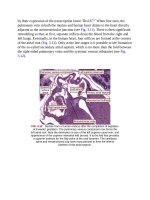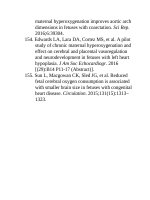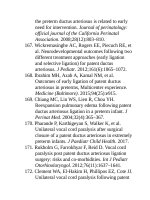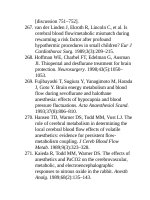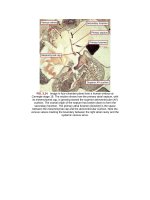Andersons pediatric cardiology 1842
Bạn đang xem bản rút gọn của tài liệu. Xem và tải ngay bản đầy đủ của tài liệu tại đây (86.4 KB, 3 trang )
Inadditiontoductalrestriction,oneetiologyofshockinaneonatewitha
fUVHwithductal-dependentsystemicbloodflowdeservesspecialmention.The
neonatewithhypoplasticleftheartsyndromeandarestrictiveatrialseptum
(usuallylessthan2to3mm)whowillappearwellinthefirstfewhoursoflife.
ButasPVRfallsandleftatrialhypertensionprogresses,suchaneonatewill
developtachypnea,hypoxemia,andeventuallyhypotension,lowcardiacoutput,
andshock.Thisphysiologyrequiresemergentcatheter-basedorsurgicalatrial
decompression.
Inourexperience,anunrestrictiveatrialseptumandlowPVRascausesof
shockpreoperativelyarerare.Inthefewdaysafterbirth,symptomsof
congestiveheartfailure(tachypnea,tachycardia,hepatomegaly)mayoccur;
however,circulatorycollapseisexceedinglyunlikely.Inbabieswithamore
indolentpictureofcongestiveheartfailure,manipulationofthePVRtomimic
thefetalcirculationissometimesundertakenwithsubatmosphericoxygenby
usingnitrogenblendedwithroomairtoinducehypoxicpulmonary
vasoconstriction).Moreinvasivestrategiesincludingintubation,sedation,
paralysis,andhypoventilationwithhypercapniaorinspiredcarbondioxidehave
alsobeenused.46,47However,wegenerallyrecommendthatbabieswithsurgical
heartdiseasedonotundergoextensivemedicalmanagement—babieswithearly
symptomsgenerallyundergoanearlyfirst-stageoperation,whereasthosewith
circulatorycollapseundergobilateralpulmonaryarterybanding(witheithera
stentorprostaglandintomaintainductalpatency).
Thepresentationoftheneonatewithamultidistributionphysiology(see
Chapter70)canbequitevaried,asdiscussedearlier.Theanatomyand
physiologymustbedelineatedandanassessmentmadeofthedeterminantsof
VO2andDO2inordertoidentifynextstepsinmanagement.
RoleofPositive-PressureVentilationintheNeonateWitha
MultidistributionCirculationandShock.
Noninvasiveandinvasivepositiveairwaypressuremaybeusedtorecruitlung
volumeandimproveoxygenation(continuouspositiveairwaypressureand
positiveend-expiratorypressure,respectively)andprovideventilatoryassistance
(bilevelpositiveairwaypressure[BiPAP]andtidalvolumeventilation,
respectively).Inaddition,mechanicalventilationunloadstherespiratorypump,
allowingfortheredistributionofalimitedQstoothervitalorgans.47aUnder
normalconditions,respiratorymuscleVO2isasmallfractionofglobalVO2.
Accordingly,therespiratorypumpreceiveslessthan5%oftotalCO.However,
asrespiratoryworkincreases—duetometabolicacidosis–induced
hyperventilation,forexample,orimpairedrespiratorymechanics—respiratory
muscleVO2mayapproach40%to50%oftotalbodyVO2.Whenthisoccurs
andCOislimited,respiratorypumpperfusionmayoccurattheexpenseofother
vitalorgans,includingthebrain.47bAlso,intheneonatewithanincreased
minuteventilationandworkofbreathing,byeliminatingexaggeratednegative
intrathoracicpressure(ITP)andincreasingITPaboveatmosphericwithpositivepressureventilation(PPV),afterloadforthesystemicventricledecreases
significantly(ventricularsystolictransmuralpressuredecreases).47cThenet
effectofthesechangesisamarkedimprovementintherespiratory,myocardial,
andglobalVO2-DO2relationship.Insummary,intubationandPPVishelpfulin
neonates—usuallywithapostnataldiagnosis—whopresentwithlowsystemic
bloodflowand/orcirculatorycollapse,whereas“elective”PPV(1)isusuallynot
indicatedand(2)canincreasesurgicalriskandcontributetohospitalmorbidity
(seeearlier).
NursingConsiderationsandFamilySupport
(SeeAlsoChapter82)
Nursesatthebedsideofthisparticularlytenuouspatientpopulationmustbe
mindfuloftheimpactofroutinecareonDO2/VO2balance,andindividualitems
shouldbeclusteredwheneverpossible.Whenpatientspresentinshock,
nonessentialcareshouldbelimitedtoavoidexcessiveVO2inthesettingof
inadequateDO2.
Admissionofaneonatetoaspecializedintensivecareunitrequiresattention
toandsupportfromtheentirefamily,particularlyinthecaseofcomplexCHD
whensurgeryisexpectedintheneonatalperiod.Bothacuteandposttraumatic
stressdisordersarecommon,havingbothshort-andlong-termimplicationsfor
thefamilyandtheneonate.Inameta-analysisofover37,000healthymothers
(ofhealthyinfants),theprevalenceofpostpartumdepressionrangesfrom8%
(Europe)to26%(MiddleEast)andisconsideredthemostcommon
complicationofpregnancy.48Theprevalenceofshort-andlong-termdepression
inmothersofinfantswithCHDhasbeenreportedmuchmorefrequentlythan
thatinfathersand,notsurprisingly,therateofsignificantmaternaldepressionis
higherthanthatincontrols.49–55Inaddition,thefrequencyishigherinmothers
whosechildrenhavemorecomplexCHD,suchasthosewithafUVHversus
milderformsofCHD.Therecognitionofmaternalanxietyanddepressionis
particularlyimportantforthebedsidestaff,sothatadequatesupportandreferrals
maybemade.
Withtheincreasingprevalenceofprenataldiagnosis,thetimingofthisinitial
supporthasshiftedfromtheCICUtothefetalheartprograms;nonetheless,the
realityoftheupcomingsurgeryandimpendingthreattotheinfant'ssurvivalmay
beoverwhelming.Evenfamilieswhoarewellsupportedthroughdiagnosisinthe
prenatalperiodarelikelytorequirehighlevelsofcontinuedsupportfollowing
birth,astheseverityofthediagnosisisoftenfullyrealizedonlyoncethechild
hasbeenborn.Challengesincludefamilyandmaritalstress,siblingmental
health,financialconsiderations,andmuchmorebeyondthescopeofthis
chapter.Itisimportantfortheentirecareteam,inparticularthebedsidenurse,to
beawareoftheseshort-andlong-termchallenges.Effortstofacilitateparental
bondingshouldbeconsideredaroutinepartofcareinthepreoperativeperiod.
Holdingoftheinfant,particularlyskintoskin,shouldberecommendedand
encouragedunlesscontradictedbyclinicalstatus.Parentsshouldbeproactively
engagedinbedsidecareandempoweredtoaskclarifyingquestionswhenthe
planofcareisbeingdiscussedwiththemedicalteam.
Finally,animportantcomponentofpreoperativesupportandeducationisto
preparethefamilyaswellaspossibleforthevisualappearanceofaneonate
followingcardiacsurgery.56–58Althoughthemedicalandnursingstaffarequite
familiarwithallofthemedicalequipment,drainagecatheters,monitors,andso
on,theshockoftheappearanceofthebabyinthemiddleofallthistechnology
canbeoverwhelming.Delayedsternalclosure,inparticular,shouldbediscussed,
andpicturesmadeavailableifpossible.59
FeedingandNutritionalChallenges
Thenutritionalstatusoftheneonateshouldbeassessedpriortopalliatingthe
neonatewithafUVH.Feedingpriortosurgeryremainscontroversial.Therisk
ofimpairedsystemicperfusionleadingtonecrotizingenterocolitismay
outweighthebenefitofenteralfeeding.However,severalstudieshaveindicated
thatinitiationofpreoperativeenteralfeedsimprovesoral-motorcoordination,
decreasesinfectionrates,andpreventsbacterialtranslocation.60–64Unlessthere
isprofoundevidenceofinadequateDO2orananatomicgastrointestinal
comorbidity,mostcenterswillallowthepreoperativeneonatewithsingle-
